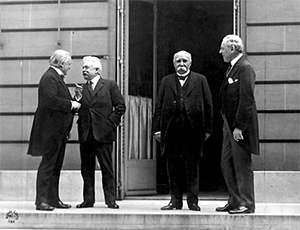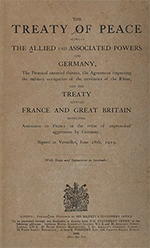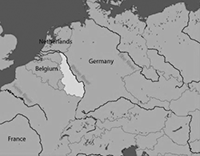The Treaty of Versailles
The Treaty of Versailles officially ended the fighting of World War I between most major powers. Stark and penetrating, it forced Germany to accept the blame for initiating and perpetuating the war. Armistice Day occurred on Nov. 1, 1918. The Armistice that ended the fighting required German troops to exit occupied Belgium, France, and Luxembourg within 15 days. Not long afterward, Allied troops occupied the Rhineland. No fighting occurred after that, but the major powers met many times in order to iron out details, with all but the United States signing the Treaty of Versailles on June 28, 1919. 
The Treaty was the result of the Paris Peace Conference, which began on Jan. 18, 1919. Dominating the discussions for the opening stages of the conference were the leaders of the four main Allied countries: (from left in photo, Prime Minister David Lloyd George of the United Kingdom, Italy's Prime Minister Vittorio Orlando, Prime Minister Georges Clemenceau of France, and U.S. President Woodrow Wilson). The "Big Four," as they came to be known, kept representatives of Germany from playing much of a part in the discussions. In fact, German delegates saw a final draft of the Treaty in May and reluctantly signed it on June 28, under the threat of the renewal of warfare if they did not. 
The place selected for the signing of the Treaty was deliberate. It was the Hall of Mirrors, in Versailles, the same place in which Germany declared its Empire after defeating France in 1870–1. The Treaty of Versailles had 440 articles, arranged in 15 parts. Some parts dealt with issues regarding prisoners of war. Others dealt with the exchange of money and land. Under the terms of the treaty, Germany:

By virtue of the Treaty of Versailles, a number of territories changed hands. Most significantly, perhaps, for Germany, France regained possession of Alsace-Lorraine, which had been the subject of disputes dating back centuries. Other transfers:
Also signing the Treaty were representatives of Japan, whose country had fought on the side of the Allies. Their Chinese counterparts, also members of the Allies, refused to sign, citing concerns over the redistribution of German colonial lands. No representatives of Russia were present because that country had earlier signed a separate treaty with Germany, the Treaty of Brest-Litovsk, and had withdrawn from the war. 
Another key element of the Treaty of Versailles negotiations was the creation of the League of Nations, an international organization designed to keep the peace. The League came into being on Jan. 10, 1920; headquarters were in Geneva, Switzerland. Nearly all of the main Allied countries joined the League of Nations. France did, as did Italy and the United Kingdom. Significantly, not joining were Germany, the Soviet Union, and the United States. President Wilson had proposed just such an international peacekeeping body in his famous Fourteen Points speech and had campaigned vigorously for the U.S. to accept the Treaty and the League; however, the U.S. Senate refused to ratify the treaty, and the U.S. subsequently did not join the League. The Treaty of Versailles applied only to Germany. Allied representatives signed other treaties with other members of the Central Powers:
|
|
Social Studies for Kids
copyright 2002–2026
David White



 forbade army conscription
forbade army conscription
